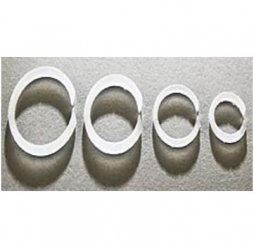

Patent Pending
- First commercially available ring (patent pending), that is available in 4 sizes: small, medium, large, x-large.
- Eliminates time-consuming chore of making them.
- Elliptical shape provides significant strength.***
- Cross-sectional size and shape decrease the need for soft tissue dissection.
- Smooth surface and tapered ends allow atraumatic passage through tissue.
- Reduced need for dissection decreases the risk of trauma to recurrent laryngeal nerves and tracheal vasculature.
- Ring width allows greater number of rings to be placed, providing greater tracheal support.
- Progressive ring sizes easily accommodate normal changes of tracheal diameter.
- Ring size allows one-pass placement of suture.
- Suture detents minimize suture migration.
- Suture detents provide multiple options for suture placement.
- Suture detents eliminate the need for holes.
- Use can reduce surgical time.
*** Unpublished study demonstrates that a normal canine trachea supported with New Generation Devices tracheal rings retains integrity and 90% of luminal diameter of 30cm of mercury vacuum pressure. Normal unsupported canine trachea collapses and loses 100% of lumen diameter at 2-3 cm of mercury vacuum pressure.

Surgical Technique for Applying New Generation Devices Prosthetic Tracheal Rings:
New Generation Devices Prosthetic Tracheal Rings offer many advantages over the old hand-made syringe case prosthesis. The advantages make ring placement less traumatic, quicker and easier. Here are a few tips for the use and application of this exciting new product.
- Have all sizes of tracheal rings available at the time of surgery. This will allow the surgeon to utilize the ring size that best approximates the outside diameter of the trachea throughout all segments to be supported.
- Choose the ring size that most closely approximates the normal outside diameter of the trachea. It is best for the ring to fit snugly against the tracheal cartilage; therefore, downsizing is preferable to having a loose fit.
- A fine right angle forceps (Pedfine Mixtar or Krantowitz) can be used to create the soft tissue tunnel around the dorsal side of the trachea with minimal trauma and tissue handling.
- One of the tapered ends of the ring is grasped with the forceps while traction is applied by hand to the opposite end of the ring; this opens up the ring for passage around the trachea.
- The forceps with the ring is withdrawn from the soft tissue tunnel, and the ring easily slips circumferentially around the trachea.
- The prosthetic ring is centered over the desired tracheal cartilage, ensuring a snug fit.
- Sutures may be placed in one-pass fashion through the tracheal cartilage and around the tracheal prosthesis.
- Exact suture placement is relationship to the ring is not critical as suture detents provide anchoring every 12 degrees around the circumference of the trachea.
- Four to seven sutures of 3-0 or 4-0 size adequately support the trachea.
- Non-absorbable monofilament sutures, 4-0 or 5-0, on a CE-4 or CP-4 needle, are appropriate and easily passed.

Order NGD products through Movora’s US or Canadian Web shops. If you are a current Movora Customer simply use your login to access the entire NGD product catalog, if you are new Movora customer, simply create a new account and a rep will approve it for purchase or call:
US: 904.436.6540 or ussales@movora.com
Canada: 905.712.8247 or canadasales@movora.com
International: 904.436.6540 or internationalsales@movora.com


